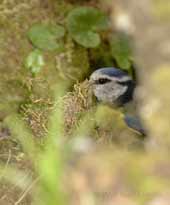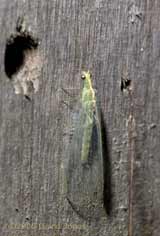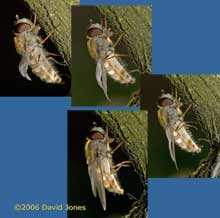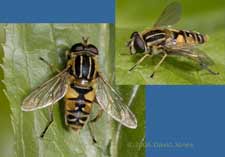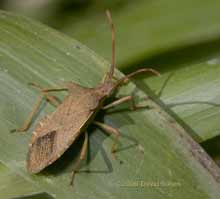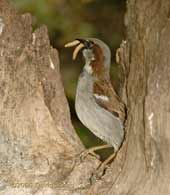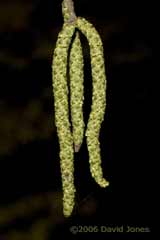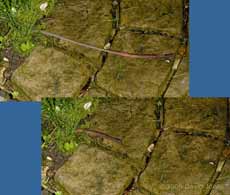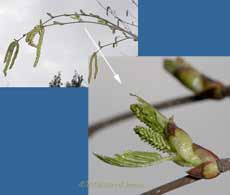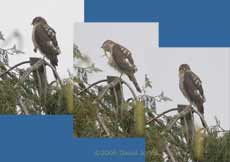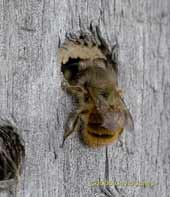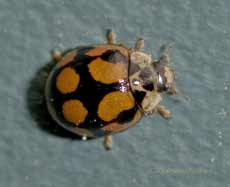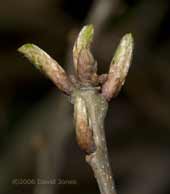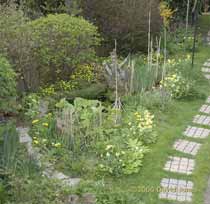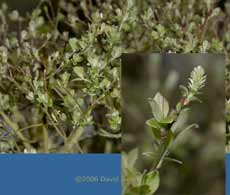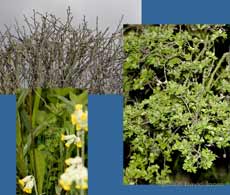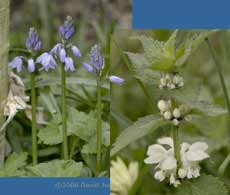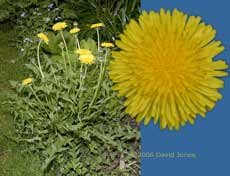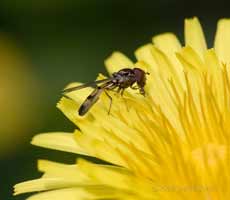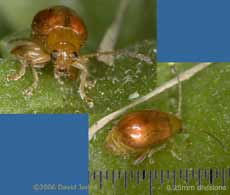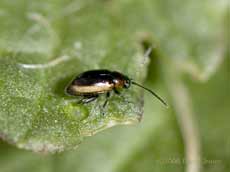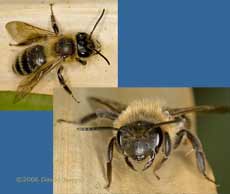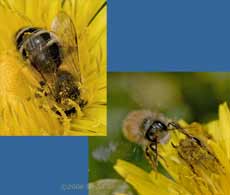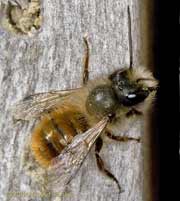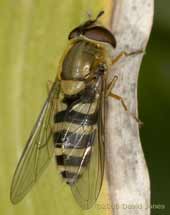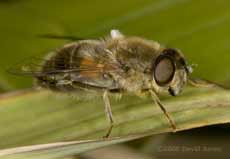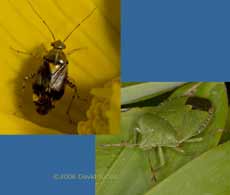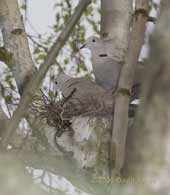Go to the last entry on this page .....Go to previous entry22 April - After a dull start it turned into a bright, sunny day by the middle of the morning - so no rain to test the water butts! I may get on with installing the pipe to the pond today after I have cut the grass.
Also, I spotted this Blue Tit collecting moss from the side of the big pond. She returned to the same spot twice, so I headed for the caravan to get a photograph. Unfortunately the spot was largely hidden from me, but I did manage this one photograph for the record. The amount she was taken suggests that this is a new nest build rather than topping up (which she wouldn't use moss for anyway). Again. I haven't established in which direction she goes with it.
Going back to last night, when I went on my nightly pond inspection I came across this Lacewing fluttering around below the Birch tree before it landed on one of the bee hotels. To give the scale, the large hole measures 7mm across.
It turned into another warm day, and the high of 18C doesn't reflect how warm it felt in the garden in the direct sunshine - I had shorts on for the first time this year as I completed the water butt task. It's now plumbed into the small pond by an underground pipe, ready for the rain to arrive!
It stayed in one place long enough for me to get some photographs as its wings were unfurled. Ten minutes elapsed between the first and last images in the sequence, after which it moved around to the far side of the branch, and out of reach of the camera.
A bit later on this hoverfly was darting around over the big pond, landing every so often on the Marsh Marigold leaves to spend time sunbathing I believe that it is a Helophilus pendulus, a hoverfly that likes damp places.
Sheila and I had coffee down the West Wing this morning, and may have come back with good news following my comments about the Blackbird and Blue Tit at the beginning of the day. First of all, the female Blackbird was definitely on her nest - I could see her tail sticking out, and before we finished she headed down the garden to feed. Perhaps she has been doing some repairs, rather than building a new nest. Secondly, the Blue Tits were going back and forth into the Ivy tree. At first I thought that they were just hunting for food, but on one visit moss was taken in. Are they nesting in there? I shall have to watch carefully over the next few days.
My coffee was interrupted by this bug (with what looked like quite bold banding on the upper surface of its abdomen) flying to the bamboo plants. Superficially similar to the Dock bug I photographs a few days ago, this one is 'slimmer', with lighter coloured legs. I believe that it is a Box Bug (Gonocerus acuteangulus).
23 April - A wet day, although the rain is light and having only a limited effect on the water depth in the butt. Nevertheless it is a welcome sight in the garden.
Another positive image at lunchtime is the sight of this House Sparrow, and his partner, taking mealworms up to one of the nestboxes on the side of the house. This is just four days later then my first record in 2005 of a sparrow taking insect food up to its nest.
At the other end of the garden, I noticed last night that the catkins on the Birch were just starting to release pollen, five days later than in 2005.
24 April - A dull but dry day with just a hint of brightness at the end of the afternoon.
The moment a torch is pointed their way they suddenly contract, pulling their bodies rapidly back into the ground. I read that the idea is to find a mate (earthworms are hermaphrodites) but I have yet to spot a pair that have met up, perhaps it happens later in the night.
While the male catkins are situated at the tips of branches, where they are best positioned to shed their pollen in the breeze, the female inflorescences are further along.
Earlier today, while outside I had to duck to avoid a collision with the Sparrowhawk as it chased a sparrow across the garden. Other than that bit of excitement the garden has been rather quiet today with only small numbers of birds coming to the feeders. It's a measure of the lack of activity that I haven't had to replace any fatballs for nearly two days (usually at least two have to be put out each day), and the sparrow feeder hasn't been refilled for a similar length of time. At least the Goldfinches are still coming.
25 April - Another grey start, and I was persuaded out of bed by the noise of the Sparrows. A peep out between the curtains was greeted by the stare of our local Sparrowhawk.
She stayed there for several minutes, and for some of that time she held one foot up as though it was injured. However, she then used it to deal with an itch before staring my way and disappearing off behind the trees.
27 April - A bright morning with sunny spells, although a mainly cloud sky. I have a bit of catching up to do after the best part of two days doing other things, namely helping one of my sons as he constructed a tall section of fencing at the bottom of the garden of the house he has just moved into, and sorting out some new tyres for our caravan ready for it summer house duties. I will be adding other things later, but I do need to record one of those moments that makes the garden all worthwhile. I had just taken some wide angle shots of the area around the big pond when I noticed activity at the bee hotel on the caravan shelter. I go to take a closer look but was distracted by a brilliant sight. A Goldcrest flew past, landed on the other side of the pond, no more than six feet from me and proceeded to bathe as I watched. Eventually it hopped out of the water and flew up into the nearest shrub to dry off and preen. As it did so, its partner (presumably) appeared and also flew down to bathe in the same spot, by which time the first bird had started hunting again. The second bird then flew up to the same spot in the shrub to preen before it too resumed its hunt for food. I've never had the chance to watch two Goldcrests at such close quarters before. I kept absolutely still (anyway, I had the 'wrong lens' on my camera) and they completely ignored me - brilliant!
Afterwards, I turned my attention back to the bee hotel briefly and took just a couple of photographs - I will be spending a lot more time with the bees as the summer progresses.
Another 'first of the year' photograph, this time of a ladybird on the side of a water butt. Very small, I think it's a 10-spot ladybird, and I only managed this one shot before it flew off. This is almost a month later than my first ladybird sighting last year.
On the plant front, the buds have burst on our Sessile Oak (in a pot).
This is the view of the area around the big pond today. Along the left-hand side of the pond (towards the far end of it) the Lesser Cellandines are now at the peak of their flowering. The rest of the yellow colouring is provided by a combination of the Cowslips, Marsh Marigolds and Field Dandelions, with a dash of purple contributed on the right by the Snake's Head Fritillaries.
At the end of the path between the ponds is another tree in a pot, a Willow (top-left in the above picture). I missed the bursting of its buds and it is now getting quite green, with the first flower inflorescences appearing.
The Hawthorn is now at the stage where the bottom half is very green (right image), and difficult to see through, while the buds on the topmost branches have only just burst (top image). There are lots of developing flower buds, so their opening is the next moment to watch for in the Hawthorn's year. The bottom-left image shows a Hawthorn sapling that is hidden amongst the vegetation on the right-hand side of the pond. Come Winter, I shall be moving this to a more suitable location.
A week ago I recorded the first Snowdrops opening. They were white ones, and it's only in the last two days that the first blue Bluebells have opened, and these are still way ahead of most of the flower-heads that I see developing. Also in this last couple of days, the White Dead-nettles have also started flowering.
We have several Field Dandelion plants coming into full flower at the moment. The one in this photograph must be close to the best example we have ever had. I know that gardeners curse them, but the flowers are magnificent and their delicate seed heads will provide food that might tempt into the garden the Greenfinches That I hear but rarely see here in the garden.
And or course, the flowers themselves provide an excellent source of nectar and pollen for visiting insects, although I only saw this one hoverfly taking advantage of them when I had my camera to hand this afternoon.
29 April - A bright day, but cool when the sun was hidden by cloud. The Blackbird is definitely nest building again, in the Ivy tree again, but this time a little lower down. Amongst the plants that are now growing quickly next to the big pond are the Ragworts. I usually remove some of these, but this year I will be allowing more to grow and flower because of their importance to the Daisy Carpenter Bees (Heriades truncorum) that will depend on them from the beginning of July when they start emerging from their nests in the bee hotels. These are a Red Data Book species which means that they are rare.
The Ragworts are also home to two types of Flea beetles, and I was able to see both today. The first was this Ragwort Flea Beetle (Longitarsus flavicornis),
and the second was this Leaf Beetle (Longitarsus dorsalis), in fact I saw three of these. This is a nationally scarce beetle - another reason to retain more of the Ragworts. I hope to get some better photographs of this beetle in the near future.
The solitary bees were more active today. I spent some time trying to get close enough to photograph them as they sunbathed on the bamboo leaves, although most of the time they were to wary to get close to.
This one was an exception. I think it is a female of the species that is visiting the bee hotel at the moment. The narrow light bands on the abdomen, and the pattern of veins on its wings suggest that it may be a member of the genus Colletidae.
Here, a similar bee was busy collecting pollen from a Dandelion, showing more clearly the wing venation. The lower image was an accidental capture when (I presume) a male swooped on the female. Notice how it has a hairy 'moustache' which is absent in the female shown above.
This bee was resting on the timber of the bee hotel. I think it could be a male, similar to the one glimpsed in the at previous shot, but the degree of hairiness of the abdomen leaves me rather uncertain - I need to watch them for longer.
The bamboo plants are always a good place to watch for visitors. Several times I saw what I think was a Tawny Mining Bee but couldn't get near it with the camera, but I did get closer to these Hoverflies - The first is this Common Hoverfly, Syrphus ribesii
and the second is this larger hoverfly. I think it may be a Drone-fly, although I didn't have a chance to get a photograph from above to check its abdominal markings, which do not show up in this shot.
Finally, a couple of bugs with appropriate colourings. First, on the right is a regular Summer visitor a Common Green Shield Bug which closely matches the green of the bamboo leaves it was resting on. The other, much smaller bug (about 5mm long) is possibly a Tarnished Plant Bug (Lygus rugulipennis) and has yellow patches that match the Marsh Marigold flower it was on. Two insects worthy of note, but not photographed, was a Bee-fly, possibly Bombylius major, which I saw feeding at a Violet, and a pair of Holly Blue Butterflies which passed through the garden without landing.
30 April - The month is ending on a dull, damp note, with it quite cool outside, 9C at 9.30am.
However, the gloomy conditions haven't put these Collared Doves from deciding to nest in my neighbour's Birch tree. While his partner works on their minimalist nest, the male has been bringing twigs to get the job done by breakfast! Click on the images to see larger versions - |
|
